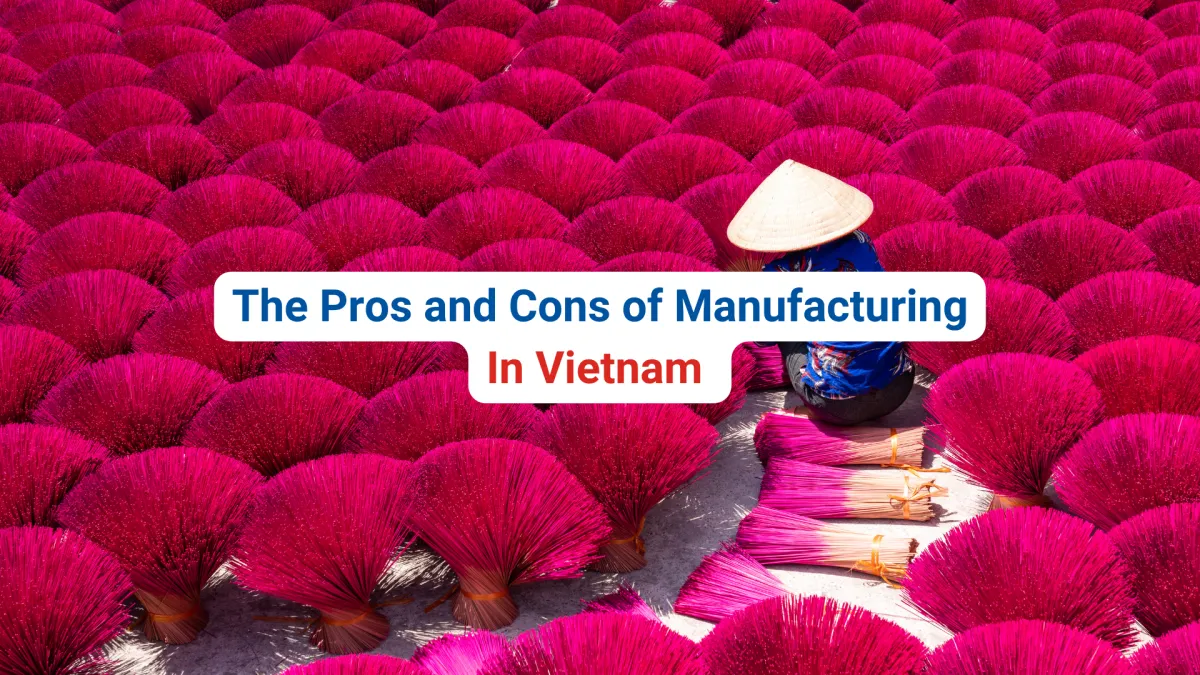
The Pros and Cons of Manufacturing in Vietnam: Is It Right for Your Business?
When considering manufacturing abroad, Vietnam often comes up as a strong contender. Over the past decade, it has emerged as a hub for global manufacturing, attracting businesses across industries due to its cost advantages, skilled workforce, and favorable trade policies. However, while manufacturing in Vietnam offers many benefits, it also comes with its own set of challenges. In this article, we’ll explore the key pros and cons of manufacturing in Vietnam to help you determine if it’s the right fit for your business.
The Pros of Manufacturing in Vietnam
1. Competitive Labor Costs
Vietnam is widely recognized for its low labor costs compared to other manufacturing powerhouses such as China, South Korea, or Mexico. With a minimum wage that varies by region but generally remains low, businesses can significantly reduce production costs without sacrificing quality.
2. Skilled and Young Workforce
Vietnam boasts a large, youthful workforce that is well-educated and highly trainable. Many workers are skilled in industries such as textiles, electronics, and furniture manufacturing. Additionally, Vietnam’s government invests heavily in vocational training programs to further upskill its labor force.
3. Diversification from China
As many companies seek to reduce dependence on China due to rising costs and geopolitical tensions, Vietnam has become a popular alternative. Known as the "China +1" strategy, businesses are diversifying their supply chains by shifting parts of their operations to Vietnam while maintaining some production in China.
4. Strategic Trade Agreements
Vietnam is a member of numerous free trade agreements (FTAs), including the Comprehensive and Progressive Agreement for Trans-Pacific Partnership (CPTPP) and the Regional Comprehensive Economic Partnership (RCEP). These agreements provide businesses with access to lower tariffs and streamlined trade processes, making it easier and more cost-effective to export goods.
5. Strong Infrastructure for Manufacturing
Vietnam has been investing heavily in infrastructure development, particularly in its industrial zones, ports, and transportation networks. Key cities such as Ho Chi Minh City, Hanoi, and Da Nang, as well as provinces like Bình Dương and Đồng Nai, host well-established industrial parks catering to various industries.
6. Government Support for Foreign Investment
The Vietnamese government actively promotes foreign investment through incentives such as tax breaks, reduced land rents, and customs exemptions. It has also streamlined administrative processes to make it easier for businesses to set up operations.
7. Growing Focus on Sustainability
Vietnam is increasingly positioning itself as a sustainable manufacturing hub. Many factories are adopting environmentally friendly practices, from using renewable energy to meeting global certifications like ISO 14001 for environmental management. This focus appeals to businesses looking for sustainable sourcing options.
The Cons of Manufacturing in Vietnam
1. Limited Manufacturing Capacity for Certain Industries
While Vietnam excels in textiles, garments, footwear, electronics, and furniture, it may lack the same capacity or expertise in more specialized manufacturing sectors, such as advanced machinery or high-tech automotive components. Businesses in niche industries might find it challenging to source the right facilities and expertise without proper help from International Trade Solutions Companies.
2. Language and Cultural Barriers
While English is increasingly spoken in business settings, it is not as widely used as in some other manufacturing hubs like India or the Philippines. Businesses may need to invest in translation services or hire bilingual staff to bridge the communication gap.
3. Limited Automation in Factories
Many factories in Vietnam rely on manual labor rather than advanced automation, which can result in slower production times and inconsistencies. This reliance on manual labor can lead to more attention to detail, handcrafted quality, and the opportunity to market products as artisan-made or uniquely crafted.
4. Concentration in Specific Industries
Vietnam’s manufacturing capabilities are heavily concentrated in industries like textiles, footwear, and electronics, which may limit options for businesses in other sectors. Specialization in certain industries means manufacturers are highly skilled and experienced in their niches, resulting in higher-quality outputs for those sectors.
5. Rapidly Changing Market
Vietnam's fast-paced economic growth and industrial development can lead to uncertainty and fluctuating costs for manufacturers and suppliers. The dynamic market presents numerous opportunities for innovation, growth, and early adoption of emerging trends, making it a fertile ground for forward-thinking businesses.
Is Vietnam Right for Your Business?
Determining whether Vietnam is the right manufacturing destination for your business depends on several factors. Avoid Sourcing Mistakes – Get Your Free Vietnam Manufacturing Checklist by downloading our FREE PDF guide.
Tips for Successfully Manufacturing in Vietnam
Conduct Thorough Research: Understand Vietnam’s manufacturing landscape and find partners with expertise in your industry.
Visit Manufacturers or Ask For Samples: If possible, visit factories to assess their capabilities, quality control processes, and working conditions.
Leverage Local Expertise: Work with sourcing agents or consultants who understand the Vietnamese market and can help navigate regulations and cultural differences.
Prioritize Quality Control: Implement strict quality control measures to ensure products meet your standards.
Build Long-Term Relationships: Developing strong relationships with local suppliers can lead to better pricing, improved communication, and long-term reliability.
Vietnam has become a manufacturing powerhouse with many benefits for businesses looking to scale globally. While it offers competitive costs, skilled labor, and strategic trade advantages, challenges such as regulatory complexities and infrastructure limitations must be carefully considered. By weighing the pros and cons and aligning them with your business goals, you can make an informed decision about whether manufacturing in Vietnam is the right move for your company.
Ready to take the next step? Explore over 130 sourcing reports here. covering a wide variety of industries and products. These reports provide vetted manufacturers already producing what you’re looking for in Vietnam, saving you time and effort. Start browsing now and unlock your business’s potential!
